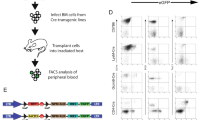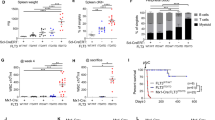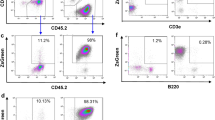Abstract
Aberrant expression of the Evi1 (ecotropic virus integration site 1) proto-oncogene has been associated with hematopoietic malignancies in both mice and man. To determine the effect of enforced expression of Evi1 in vivo, we developed a transgenic mouse model utilizing the murine Sca-1 (Ly-6E.1) promoter. Here, we describe the generation and analysis of three independent lines of Evi1 transgenic mice. Transgenic animals of two founder lines developed normally. These mice did not show any obvious hematological abnormalities but showed a significant reduction in the number of bone marrow colony-forming unit erythroid (CFU-E)-derived colonies. This implies a defect of normal erythroid hematopoiesis affecting relatively late erythroid progenitor cells. We also show that when newborn Evi1 transgenic mice of these two lines were infected with Cas-Br-M MuLV, tumor incidence was greatly enhanced in comparison with nontransgenic littermates, indicating an increased susceptibility for leukemia development. Interestingly, analysis of a third founder line revealed that all male progeny consistently displayed severely impaired erythropoiesis with major defects in the bone marrow, spleen and peripheral blood. Taken together, our results present the first evidence of Evi1 disturbing normal erythropoiesis in vivo and provides evidence for cooperative potential of Evi1 in tumor progression.
This is a preview of subscription content, access via your institution
Access options
Subscribe to this journal
Receive 12 print issues and online access
$259.00 per year
only $21.58 per issue
Buy this article
- Purchase on Springer Link
- Instant access to full article PDF
Prices may be subject to local taxes which are calculated during checkout








Similar content being viewed by others
References
Morishita K, Parker DS, Mucenski ML, Jenkins NA, Copeland NG, Ihle JN . Retroviactivation of a novel gene encoding a zinc finger protein in IL-3-dependent myeloid leukemia cell lines Cell 1988 54: 831–840
Fichelson S, Dreyfus F, Berger R, Melle J, Bastard C, Miclea JM, Gisselbrecht S . Evi-1 expression in leukemic patients with rearrangements of the 3q25-q28 chromosomal region Leukemia 1992 6: 93–99
Morishita K, Parganas E, William CL, Whittaker MH, Drabkin H, Oval J, Taetle R, Valentine MB, Ihle JN . Activation of EVI1 gene expression in human acute myelogenous leukemias by translocations spanning 300–400 kilobases on chromosome band 3q26 Proc Natl Acad Sci USA 1992 89: 3937–3941
Suzukawa K, Parganas E, Gajjar A, Abe T, Takahashi S, Tani K, Asano S, Asou H, Kamada N, Yokota J . Identification of a breakpoint cluster region 3′ of the ribophorin I gene at 3q21 associated with the transcriptional activation of the EVI1 gene in acute myelogenous leukemias with inv(3)(q21q26) Blood 1994 84: 2681–2688
Jenkins RB, Tefferi A, Solberg LA Jr, Dewald GW . Acute leukemia with abnormal thrombopoiesis and inversions of chromosome 3 Cancer Genet Cytogenet 1989 39: 167–179
Morishita K, Parganas E, Bartholomew C, Sacchi N, Valentine MB, Raimondi SC, Le Beau MM, Ihle JN . The human Evi-1 gene is located on chromosome 3q24-q28 but is not rearranged in three cases of acute nonlymphocytic leukemias containing t(3;5)(q25;q34) translocations Oncogene Res 1990 5: 221–231
Russell M, List A, Greenberg P, Woodward S, Glinsmann B, Parganas E, Ihle J, Taetle R . Expression of EVI1 in myelodysplastic syndromes and other hematologic malignancies without 3q26 translocations Blood 1994 84: 1243–1248
Ogawa S, Kurokawa M, Tanaka T, Tanaka K, Hangaishi A, Mitani K, Kamada N, Yazaki Y, Hirai H . Increased Evi-1 expression is frequently observed in blastic crisis of chronic myelocytic leukemia Leukemia 1996 10: 788–794
Carapeti M, Goldman JM, Cross NC . Overexpression of EVI-1 in blast crisis of chronic myeloid leukemia (letter) Leukemia 1996 10: 1561
Delwel R, Funabiki T, Kreider BL, Morishita K, Ihle JN . Four of the seven zinc fingers of the Evi-1 myeloid-transforming gene are required for sequence-specific binding to GA(C/T)AAGA(T/C)AAGATAA Mol Cell Biol 1993 13: 4291–4300
Perkins AS, Fishel R, Jenkins NA, Copeland NG . Evi-1, a murine zinc finger proto-oncogene, encodes a sequence-specific DNA-binding protein Mol Cell Biol 1991 11: 2665–2674
Wall L, deBoer E, Grosveld F . The human beta-globin gene 3′ enhancer contains multiple binding sites for an erythroid-specific protein Genes Dev 1988 2: 1089–1100
Evans T, Reitman M, Felsenfeld G . An erythrocyte-specific DNA-binding factor recognizes a regulatory sequence common to all chicken globin genes Proc Natl Acad Sci USA 1988 85: 5976–5980
Weiss MJ, Orkin SH . GATA transcription factors: key regulators of hematopoiesis Exp Hematol 1995 23: 99–107
Kreider BL, Orkin SH, Ihle JN . Loss of erythropoietin responsiveness in erythroid progenitors due to expression of the Evi-1 myeloid-transforming gene Proc Natl Acad Sci USA 1993 90: 6454–6458
Morishita K, Parganas E, Matsugi T, Ihle JN . Expression of the Evi-1 zinc finger gene in 32Dc13 myeloid cells blocks granulocytic differentiation in response to granulocyte colony-stimulating factor Mol Cell Biol 1992 12: 183–189
Tanaka T, Nishida J, Mitani K, Ogawa S, Yazaki Y, Hirai H . Evi-1 raises AP-1 activity and stimulates c-fos promoter transactivation with dependence on the second zinc finger domain J Biol Chem 1994 269: 24020–24026
Morishita K, Suzukawa K, Taki T, Ihle JN, Yokota J . EVI-1 zinc finger protein works as a transcriptional activator via binding to a consensus sequence of GACAAGATAAGATAAN1-28 CTCATCTTC Oncogene 1995 10: 1961–1967
Lopingco MC, Perkins AS . Molecular analysis of Evi1, a zinc finger oncogene involved in myeloid leukemia Curr Top Microbiol Immunol 1996 211: 211–222
Soderholm J, Kobayashi H, Mathieu C, Rowley JD, Nucifora G . The leukemia-associated gene MDS1/EVI1 is a new type of GATA-binding transactivator Leukemia 1997 11: 352–358
Bartholomew C, Kilbey A, Clark AM, Walker M . The Evi-1 proto-oncogene encodes a transcriptional repressor activity associated with transformation Oncogene 1997 14: 569–577
Kurokawa M, Mitani K, Irie K, Matsuyama T, Takahashi T, Chiba S, Yazaki Y, Matsumoto K, Hirai H . The oncoprotein Evi-1 represses TGF-beta signalling by inhibiting Smad3 Nature 1998 394: 92–96
Kurokawa M, Mitani K, Imai Y, Ogawa S, Yazaki Y, Hirai H . The t(3;21) fusion product, AML1/Evi-1, interacts with Smad3 and blocks transforming growth factor-beta-mediated growth inhibition of myeloid cells Blood 1998 92: 4003–4012
Sinclair AM, Dzierzak EA . Cloning of the complete Ly-6E.1 gene and identification of DNase I hypersensitive sites corresponding to expression in hematopoietic cells Blood 1993 82: 3052–3062
Miles C, Sanchez MJ, Sinclair A, Dzierzak E . Expression of the Ly-6E.1 (Sca-1) transgene in adult hematopoietic stem cells and the developing mouse embryo Development 1997 124: 537–547
van Lohuizen M, Verbeek S, Krimpenfort P, Domen J, Saris C, Radaszkiewicz T, Berns A . Predisposition to lymphomagenesis in pim-1 transgenic mice: cooperation with c-myc and N-myc in murine leukemia virus-induced tumors Cell 1989 56: 673–682
Haupt Y, Alexander WS, Barri G, Klinken SP, Adams JM . Novel zinc finger gene implicated as myc collaborator by retrovirally accelerated lymphomagenesis in E mu-myc transgenic mice (see comments) Cell 1991 65: 753–763
Haupt Y, Harris AW, Adams JM . Retroviral infection accelerates T lymphomagenesis in E mu-N-ras transgenic mice by activating c-myc or N-myc Oncogene 1992 7: 981–986
Hogan B BR, Costantini F, Lacy E . Manipulating the Mouse Embryo, A Laboratory Manual (edn 2) Cold Spring Harbor Laboratory Press: Cold Spring Harbor, NY 1994
Sambrook J, Fritsch FE, Maniatis T . Molecular Cloning, A Laboratory Manual (edn 2) Cold Spring Harbor Laboratory Press: Cold Spring Harbor, NY 1989
Jenkins JR, Ayton P, Jones T, Davies SL, Simmons DL, Harris AL, Sheer D, Hickson ID . Isolation of cDNA clones encoding the beta isozyme of human DNA topoisomerase II and localisation of the gene to chromosome 3p24 Nucleic Acids Res 1992 20: 5587–5592
Holmes KL, Palaszynski E, Fredrickson TN, Morse HCd, Ihle JN . Correlation of cell-surface phenotype with the establishment of interleukin 3-dependent cell lines from wild-mouse murine leukemia virus-induced neoplasms Proc Natl Acad Sci USA 1985 82: 6687–6691
Kimura S, Tada N, Liu-Lam Y, Hammerling U . Studies of the mouse Ly-6 alloantigen system. II. Complexities of the Ly-6 region Immunogenetics 1984 20: 47–56
Spangrude GJ, Aihara Y, Weissman IL, Klein J . The stem cell antigens Sca-1 and Sca-2 subdivide thymic and peripheral T lymphocytes into unique subsets J Immunol 1988 141: 3697–3707
van de Rijn M, Heimfeld S, Spangrude GJ, Weissman IL . Mouse hematopoietic stem-cell antigen Sca-1 is a member of the Ly-6 antigen family Proc Natl Acad Sci USA 1989 86: 4634–4638
Dreyfus F, Bouscary D, Melle J, Ribrag V, Guesnu M, Varet B . Expression of the Evi-1 gene in myelodysplastic syndromes Leukemia 1995 9: 203–205
Schnittger S, Schoch C, Streubel B, Hinrichs HF, Otremba B, Parwaresch R, Fonatsch C . A case of atypical myelodysplastic syndrome with micromegakaryocytes, normal platelet count, and t(3;12)(q21;p13) with inv(3)(q21q26) Genes Chromosomes Cancer 1997 20: 292–298
Kouides PA, Bennett JM . Morphology and classification of myelodysplastic syndromes Hematol Oncol Clin North Am 1992 6: 485–499
Shivdasani RA, Orkin SH . The transcriptional control of hematopoiesis (see comments) Blood 1996 87: 4025–4039
Acknowledgements
We thank Dr Elaine Dzierzak for providing the Sca-1 (Ly-6E.1) cassette (pL6Cla), Dr Nico de Both for histopathological analysis, Dr Rosalyn Slater and Bep Smit for FISH analysis, Trudi Visser for technical assistance on colony cultures and Karola van Rooyen for preparation of figures. This work was supported by the Dutch Cancer Society (KWF), the Netherlands Organization for Scientific Research (NWO) and the Royal Dutch Academy of Sciences (KNAW).
Author information
Authors and Affiliations
Rights and permissions
About this article
Cite this article
Louz, D., van den Broek, M., Verbakel, S. et al. Erythroid defects and increased retrovirally-induced tumor formation in Evi1 transgenic mice. Leukemia 14, 1876–1884 (2000). https://doi.org/10.1038/sj.leu.2401887
Received:
Accepted:
Published:
Issue Date:
DOI: https://doi.org/10.1038/sj.leu.2401887
Keywords
This article is cited by
-
EVI1 overexpression reprograms hematopoiesis via upregulation of Spi1 transcription
Nature Communications (2018)
-
Stem cell origin of myelodysplastic syndromes
Oncogene (2014)
-
MYBL2 haploinsufficiency increases susceptibility to age-related haematopoietic neoplasia
Leukemia (2013)
-
EVI1 overexpression in distinct subtypes of pediatric acute myeloid leukemia
Leukemia (2010)
-
Leukemia induction after a single retroviral vector insertion in Evi1 or Prdm16
Leukemia (2008)



